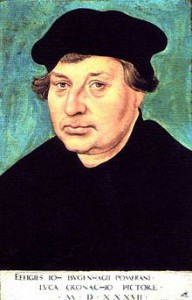FAITH OF OUR FATHERS: Brief sketches of other influential figures at the time of the Reformation. Includes Bugenhagen, Melanchthon, Jonas, Cranach, Spalatin, and Chemnitz.
[These vignettes of men associated with Luther and the Reformation first appeared in connection with our CLC’s daily website devotions during Reformation season, 2013. Pastor David Schaller, Redeemer Lutheran Church, Sister Lakes, Mich., reports that the devotions were adapted from a Bible Class presentation, adding that “The original booklet and slides can be downloaded from our church website at http://www.redeemerclc.info/devotional.html — Go down the page until you see the ‘Faith of Our Fathers’ presentation.” – May the Holy Spirit bless our observance of this special season of the church year! — Editor]
FAITH OF OUR FATHERS
(first of four)
“Keep watch over yourselves and all the flock of which the Holy Spirit has made you overseers. Be shepherds of the church of God, which he bought with his own blood.” (Acts 20:28, NIV1984)
In early sixteenth century Germany the Lord God used the life and work of Martin Luther to shine a light on the central teaching of the Bible: We gain heaven not on account of our own good deeds but because Jesus lived a perfect life and suffered for our sins. Yet while we refer to that period in history today as the “Lutheran” Reformation, the Holy Spirit was surely active in others besides Luther, leading them along the same path of discovery, uncovering for them too the precious truth of the gospel.
 One of those others was John Bugenhagen. In 1504 at the age of nineteen, Bugenhagen became a teacher and the principal of the school in Treptow, a town on the Rega River in what is today northern Poland. As it happened, although his chosen career was not strictly theological in nature, he had much contact with the church through his students as well as through a nearby monastery. Eventually, at the urging of his friends and with an inner desire for the ministry growing within him, he studied for the priesthood and was ordained in 1509 at the age of twenty-four, becoming vicar of St. Mary’s church in Treptow.
One of those others was John Bugenhagen. In 1504 at the age of nineteen, Bugenhagen became a teacher and the principal of the school in Treptow, a town on the Rega River in what is today northern Poland. As it happened, although his chosen career was not strictly theological in nature, he had much contact with the church through his students as well as through a nearby monastery. Eventually, at the urging of his friends and with an inner desire for the ministry growing within him, he studied for the priesthood and was ordained in 1509 at the age of twenty-four, becoming vicar of St. Mary’s church in Treptow.
As a priest, Bugenhagen believed that a person could earn heaven through a series of good deeds and that he could make up for his own sins. He admitted later in an autobiographical commentary that before 1520 he attempted to achieve righteousness before God through good works and confession.
What changed in 1520? That was the year Luther’s essay on “The Babylonian Captivity of the Church” was published. This was the work that convinced Bugenhagen he needed to study carefully what the Bible taught about salvation by faith. The Holy Spirit led Bugenhagen to see this truth of Scripture, and he found himself in agreement with Luther. In 1521 he moved to Wittenberg, Luther’s hometown. While Martin was away at the Diet (Council) of Worms delivering his famous “Here I Stand” address, Bugenhagen taught his classes at the university.
In 1523 Bugenhagen became pastor of St. Mary’s church in Wittenberg. Thus he became Luther’s pastor, and the Lord used him to help shepherd Luther around the many spiritual pitfalls and dangers that beset him. Bugenhagen was always a pastor at heart, shepherding the church of God which Christ had bought with his own blood. He did not have the analytical mind of a Luther or a Melanchthon, but he was a gifted organizer and contributed greatly to preserving unity in the early days of the Lutheran church. He died in 1558 at
the age of seventy-three, a pastor in Wittenberg to the last.
(To read more about John Bugenhagen, try the brief biography by Walter Ruccius available free of charge online: http://archive.org/details/johnbugenhagenpo00rucc)


